SSANGYONG KYRON 2008 Service Manual
Manufacturer: SSANGYONG, Model Year: 2008, Model line: KYRON, Model: SSANGYONG KYRON 2008Pages: 650, PDF Size: 73.24 MB
Page 191 of 650
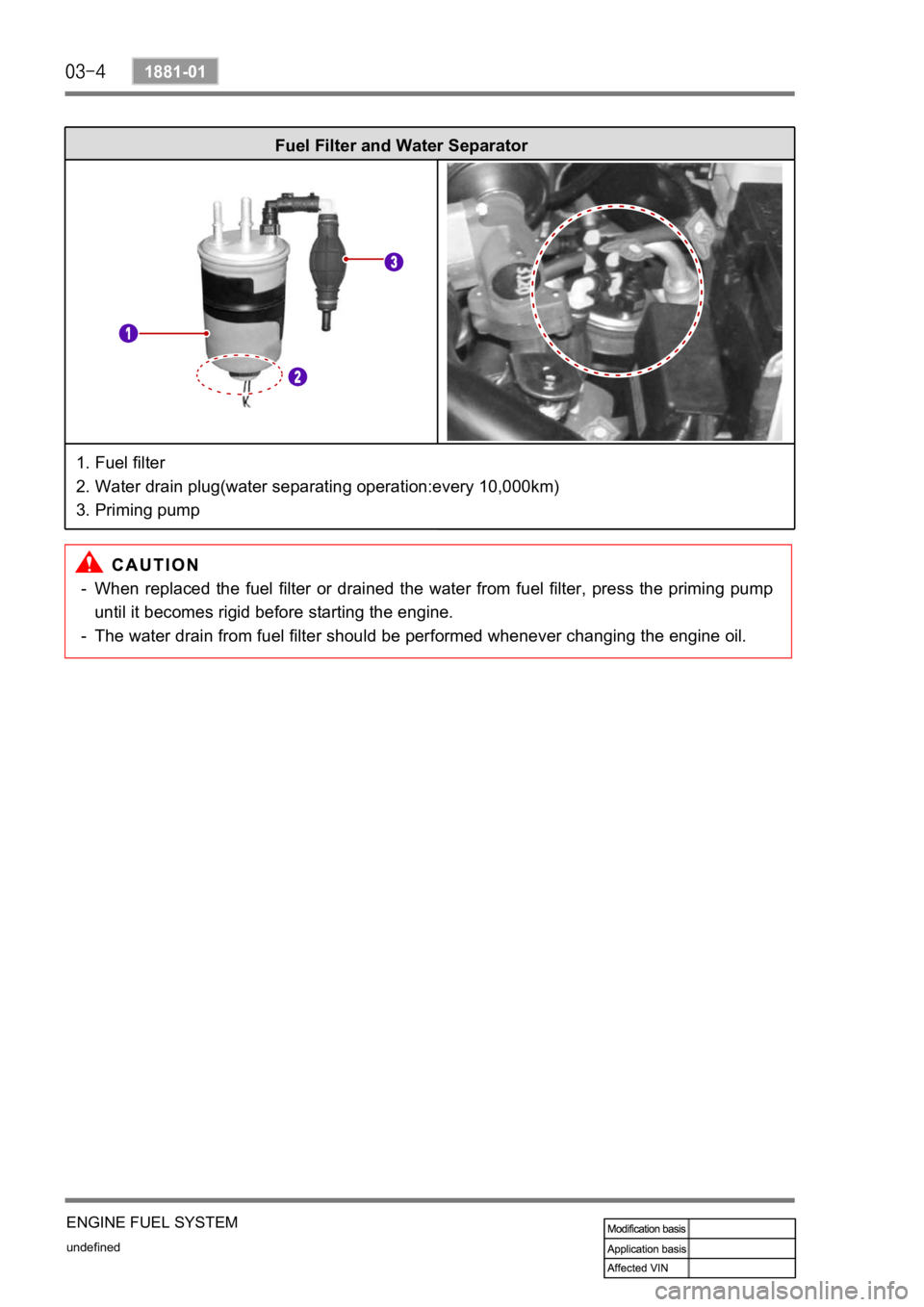
undefined
1881-01
ENGINE FUEL SYSTEM
Fuel Filter and Water Separator
1. Fuel filter
2. Water drain plug(water separating operation:every 10,000km)
3. Priming pump
When replaced the fuel filter or drained the water from fuel filter, press the priming pump
until it becomes rigid before starting the engine.
The water drain from fuel filter should be performed whenever changing the engine oil. -
-
Page 192 of 650
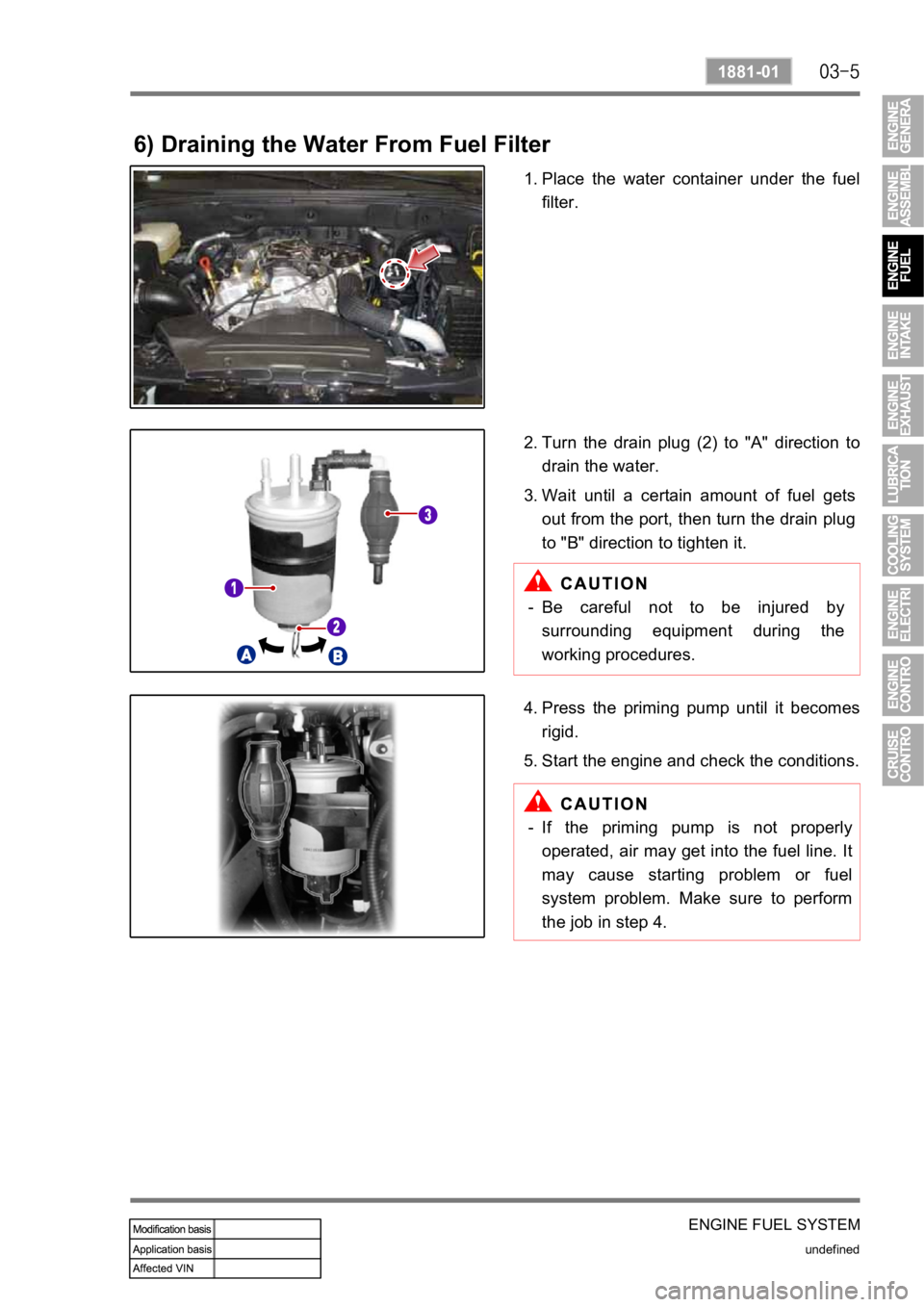
ENGINE FUEL SYSTEM
undefined
1881-01
6) Draining the Water From Fuel Filter
Place the water container under the fuel
filter. 1.
Turn the drain plug (2) to "A" direction to
drain the water. 2.
Wait until a certain amount of fuel gets
out from the port, then turn the drain plug
to "B" direction to tighten it. 3.
Be careful not to be injured by
surrounding equipment during the
working procedures. -
Press the priming pump until it becomes
rigid. 4.
Start the engine and check the conditions. 5.
If the priming pump is not properly
operated, air may get into the fuel line. It
may cause starting problem or fuel
system problem. Make sure to perform
the job in step 4. -
Page 193 of 650

undefined
1881-01
ENGINE FUEL SYSTEM
OVERVIEW AND OPERATION PROCESS
1. ELECTRONIC CONTROL OF FUEL SYSTEM
According to input signals from various sensors, engine ECU calculates driver's demand
(position of the accelerator pedal) and then controls overall operating performance of engine
and vehicle on that time.
ECU receives signals from sensors via data line and then performs effective engine air-fuel
ratio controls based on those signals. Engine speed is measured by crankshaft speed (position)
sensor and camshaft speed (position) sensor determines injection order and ECU detects
driver's pedal position (driver's demand) through electrical signal that is generated by variable
resistance changes in accelerator pedal sensor. Air flow (hot film) sensor detects intake ai
r
volume and sends the signals to ECU. Especially, the engine ECU controls the air-fuel ratio by
recognizing instant air volume changes from air flow sensor to decrease the emissions (EGR
valve control). Furthermore, ECU uses signals from coolant temperature sensor and ai
r
temperature sensor, booster pressure sensor and atmospheric pressure sensor as
compensation signal to respond to injection starting, pilot injection set values, various
operations and variables.Components
High pressure fuel pump
Fuel injectors -
-Fuel rail
Electronic control unit(ECU) -
-Fuel pressure sensor
Various sensors and actuators -
-Supply line
Return line
ECU connecting line
Page 194 of 650

ENGINE FUEL SYSTEM
undefined
1881-01
Fuel Line System
Fuel route
2. COMPOSITION OF FUEL SYSTEM
Components in fuel system are designed to generate and distribute high pressure, and they are
controlled electronically by engine ECU. Accordingly, fuel system is completely different from
injection pump type fuel supply system on the conventional Diesel engine. The fuel injection
system in common rail engine is composed of transfer pressure section that transfers fuel in
low pressure, high pressure section that transfers fuel in high pressure and ECU control
section.
High pressure pipe
Common rail
Fuel pressure
sensor
Priming pump
Fuel pump
(High pressure pump, transfer pump)
Fuel filter
Injector
D20DT: 4 EA
D27DT: 5 EA
common rail
Page 195 of 650

undefined
1881-01
ENGINE FUEL SYSTEM
3. HYDRAULIC CYCLE IN FUEL LINE
(TRANSFER AND HIGH PRESSURE LINE)
High pressure supply line
Transfer pressure supply
line Return line
Page 196 of 650
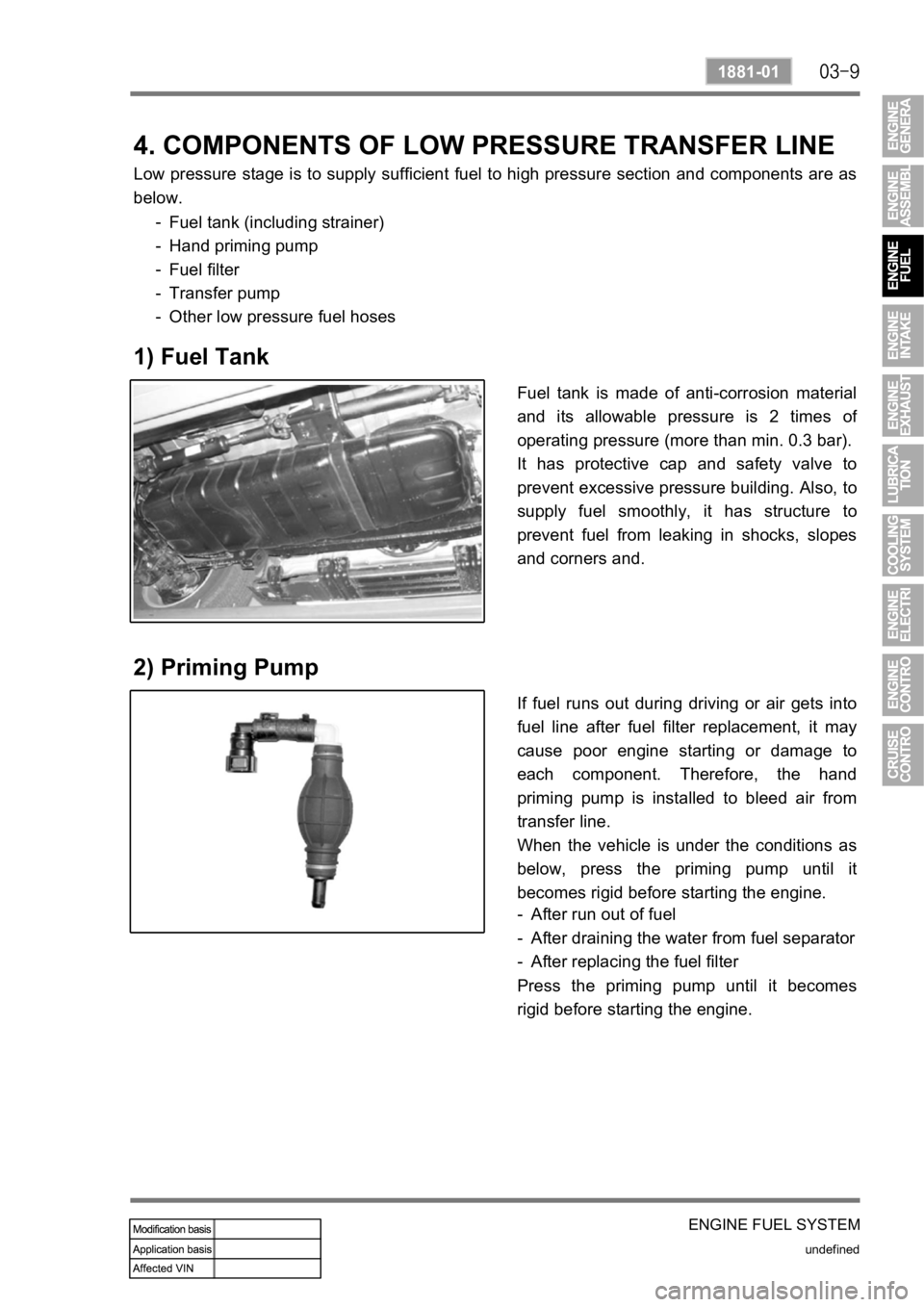
ENGINE FUEL SYSTEM
undefined
1881-01
4. COMPONENTS OF LOW PRESSURE TRANSFER LINE
Low pressure stage is to supply sufficient fuel to high pressure section and components are as
below.
Fuel tank (including strainer)
Hand priming pump
Fuel filter
Transfer pump
Other low pressure fuel hoses -
-
-
-
-
1) Fuel Tank
Fuel tank is made of anti-corrosion material
and its allowable pressure is 2 times o
f
operating pressure (more than min. 0.3 bar).
It has protective cap and safety valve to
prevent excessive pressure building. Also, to
supply fuel smoothly, it has structure to
prevent fuel from leaking in shocks, slopes
and corners and.
If fuel runs out during driving or air gets into
fuel line after fuel filter replacement, it may
cause poor engine starting or damage to
each component. Therefore, the hand
priming pump is installed to bleed air from
transfer line.
When the vehicle is under the conditions as
below, press the priming pump until it
becomes rigid before starting the engine.
2) Priming Pump
After run out of fuel
After draining the water from fuel separator
After replacing the fuel filter -
-
-
Press the priming pump until it becomes
rigid before starting the engine.
Page 197 of 650
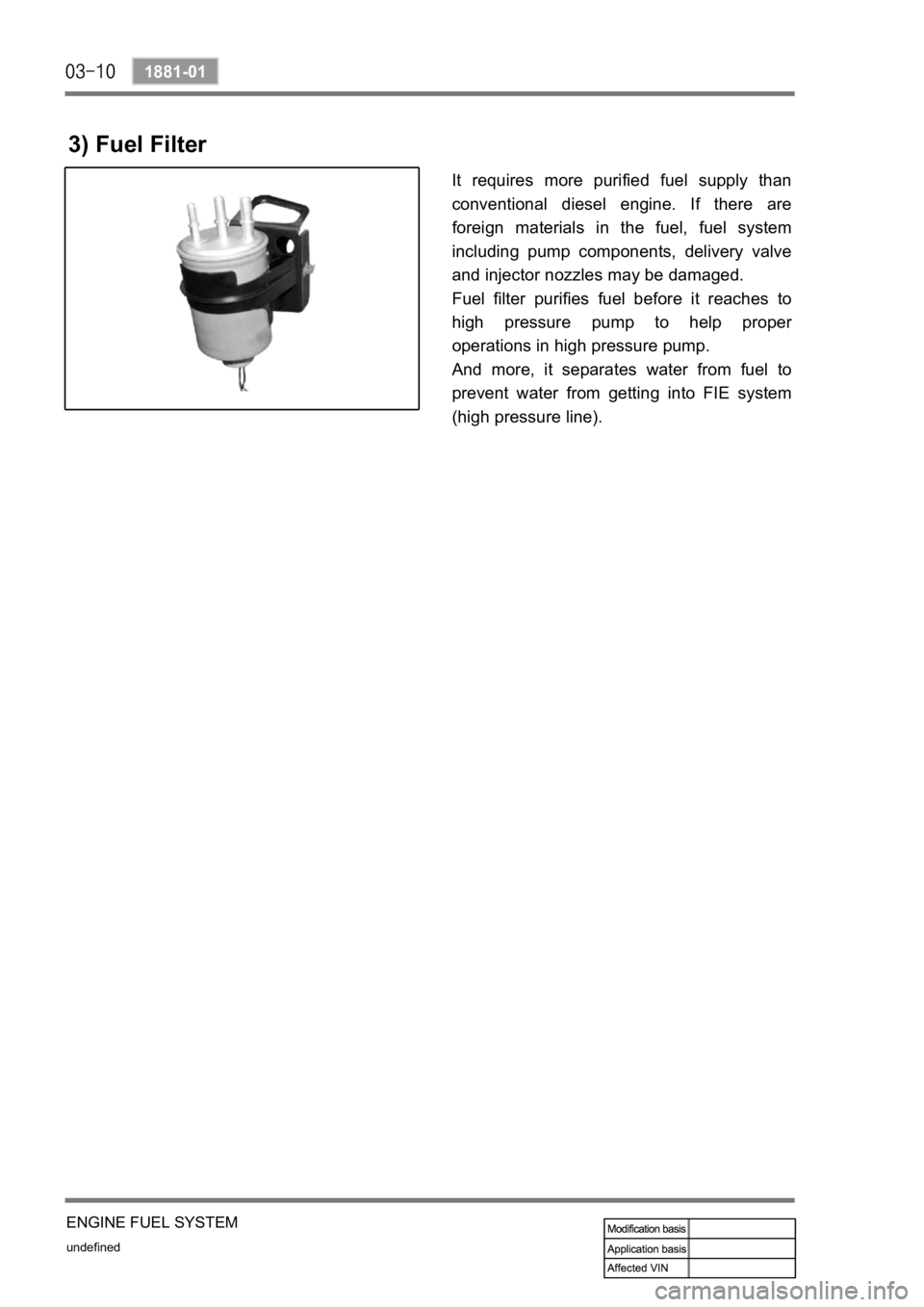
undefined
1881-01
ENGINE FUEL SYSTEM
It requires more purified fuel supply than
conventional diesel engine. If there are
foreign materials in the fuel, fuel system
including pump components, delivery valve
and injector nozzles may be damaged.
Fuel filter purifies fuel before it reaches to
high pressure pump to help prope
r
operations in high pressure pump.
And more, it separates water from fuel to
prevent water from getting into FIE system
(high pressure line).
3) Fuel Filter
Page 198 of 650

ENGINE FUEL SYSTEM
undefined
1881-01
5. COMPONENTS OF HIGH PRESSURE TRANSFER LINE
In the high pressure section, sufficient fuel pressure that injectors requires will be generated
and stored. The components are as below:
High pressure pump
Rail pressure sensor
Pressure limit valve
Common rail
High pressure pipe
Injector
Fuel pressure regulating valve (IMV) -
-
-
-
-
-
-
This is plunger pump that generates high
pressure and driven by crankshaft with
timing chain. The high pressure pump
increases system pressure of fuel to approx.
1,600 bar and this compressed fuel is
transferred to high pressure accumulato
r
(common rail) in tube through high pressure
line.
1) High Pressure Pump
It stores fuel transferred from high pressure
pump and also stores actual high pressure
of fuel. Even though the injectors inject fuel
from the rail, the fuel pressure in the rail is
maintained to a specific value. It is because
the effect of accumulator is increased by
unique elasticity of fuel. Fuel pressure is
measured by rail pressure sensor.
And the fuel pressure regulating valve (IMV,
Inlet Metering Valve) included in high
pressure pump housing keeps pressure to a
desired level.
2) Common Rail
Page 199 of 650
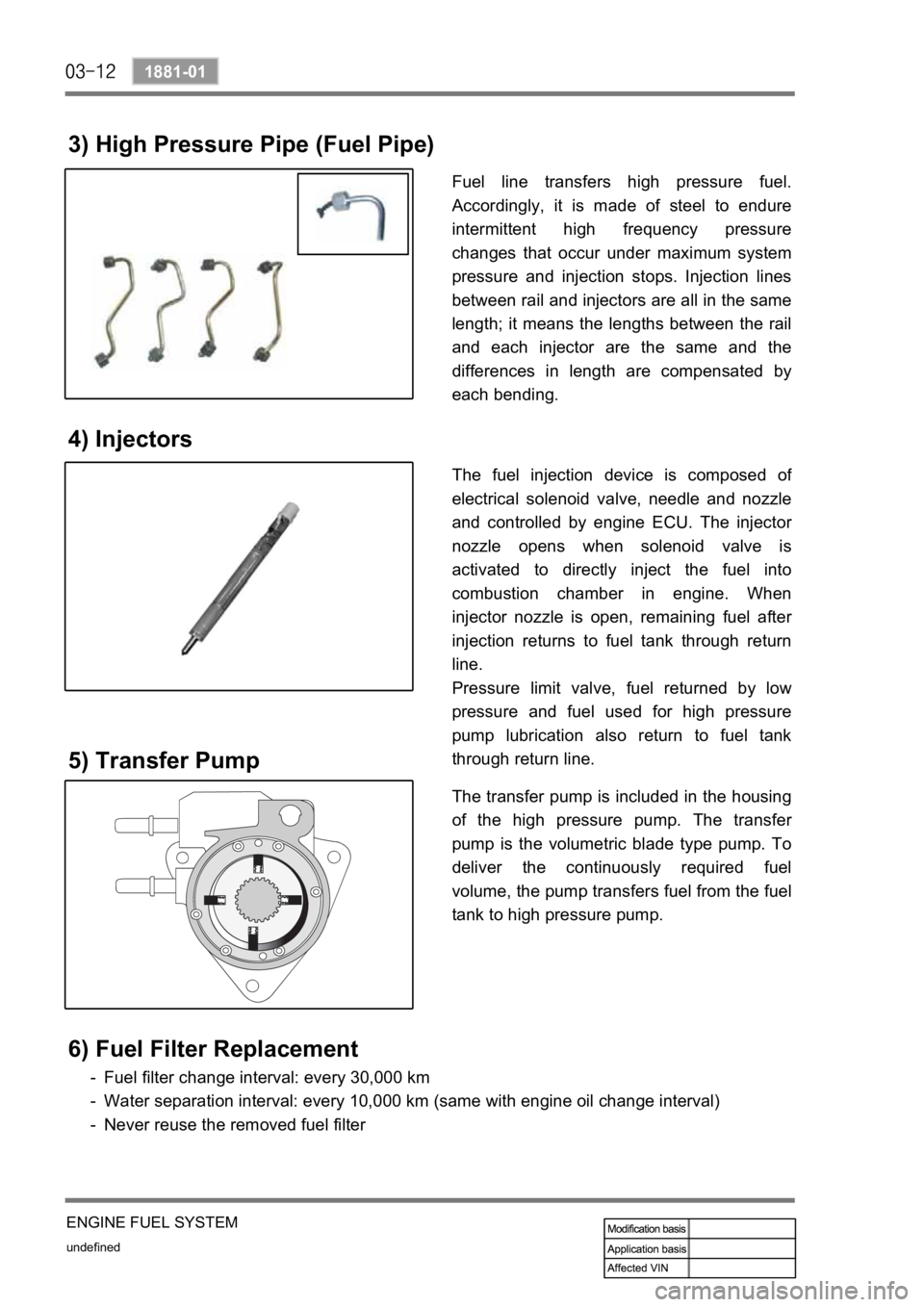
undefined
1881-01
ENGINE FUEL SYSTEM
3) High Pressure Pipe (Fuel Pipe)
Fuel line transfers high pressure fuel.
Accordingly, it is made of steel to endure
intermittent high frequency pressure
changes that occur under maximum system
pressure and injection stops. Injection lines
between rail and injectors are all in the same
length; it means the lengths between the rail
and each injector are the same and the
differences in length are compensated by
each bending.
4) Injectors
The fuel injection device is composed of
electrical solenoid valve, needle and nozzle
and controlled by engine ECU. The injecto
r
nozzle opens when solenoid valve is
activated to directly inject the fuel into
combustion chamber in engine. When
injector nozzle is open, remaining fuel afte
r
injection returns to fuel tank through return
line.
Pressure limit valve, fuel returned by low
pressure and fuel used for high pressure
pump lubrication also return to fuel tank
through return line.
6) Fuel Filter Replacement
Fuel filter change interval: every 30,000 km
Water separation interval: every 10,000 km (same with engine oil change interval)
Never reuse the removed fuel filter -
-
-
The transfer pump is included in the housing
of the high pressure pump. The transfe
r
pump is the volumetric blade type pump. To
deliver the continuously required fuel
volume, the pump transfers fuel from the fuel
tank to high pressure pump.
5) Transfer Pump
Page 200 of 650

ENGINE FUEL SYSTEM
undefined
1881-01
6. CIRCUIT DIAGRAM